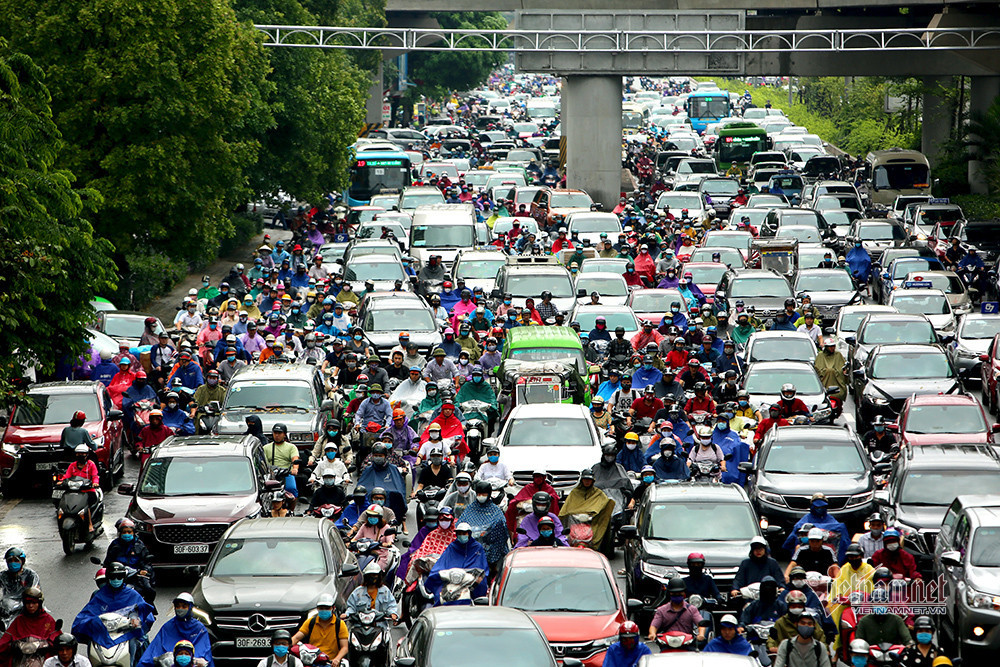
According to IQAir, the air pollution index in Hanoi was 213 at 7 am October 9, the second highest in the world. This is the threshold harmful to human health.
The air pollution in large cities in recent days have been alarming. On October 7, both Hanoi and HCM City were among the most polluted large cities in the world. The air pollution index in Hanoi on that day was 174, while it was 147 in HCM City, and the air quality was not good for sensitive people.
Hoang Duong Tung, chair of the Vietnam Clean Air Network, said that Hanoi and many other cities in Vietnam are suffering from serious air pollution, mainly attributed to the high number of privately owned vehicles.
“There are many motorbikes and automobiles running with fossil fuel. There is no regulation on emission control for motorbikes, so their owners feel free to emit black smoke,” Tung said.
“These are the major pollution sources in large cities,” he concluded.
A report of the Southern Center for Environment Monitoring under the Ministry of Natural Resources and the Environment (MONRE) said in 2023 70 percent of polluting emissions came from transport vehicles. The emissions have been increasing year after year, together with the increase in the number of vehicles, especially private vehicles.
According to experts, if every car and motorbike in traffic is considered a "mobile emission station", Vietnam now has 80.6 million such stations (the number of vehicles registered by the end of 2023), including 6.3 million cars and 74.3 million motorbikes.
Pattrick Haverman, deputy chief representative of the UNDP, cited a report in 2016 as saying that the transport sector made up 18 percent of greenhouse gas emissions.
He warned that if Vietnam doesn’t take action right now, emissions would rise to 64.3 million tons of carbon by 2025 and 88.1 million tons by 2030.
Therefore, reducing emissions and even closing emission sources are urgent. This not only is in line with global trends, but is also an important task Vietnam has to fulfill if it wants to reduce net emissions to zero by 2050 as committed by the government of Vietnam.
Greenizing means of transport
At a recent workshop discussing solutions to automobile emission reduction, Director of the Institute for Carbon Finance Development Consulting (CODE) Le Xuan Nghia said that electric vehicles could help reduce greenhouse gas emissions in the next decade.
However, he stressed the need to change consumer views on EVs (electric vehicles). International practice shows that in order to do this, it is necessary to boost domestic consumption. In South Korea, for example, all public vehicles are manufactured in South Korea, which helps create confidence from consumers and ignites the movement to prioritize use of domestically made products.
Vietnam can apply the method by shifting from gasoline-run vehicles to EVs when buying vehicles for public use.
He noted that people’s and businesses’ awareness of EVs has changed recently. EVs have caught more attention from the public and become a priority for many people, because they are more economical and also reduce emissions.
The Ministry of Public Security (MPS) has pioneered the movement as it has bought 70 EVs for traffic police. It is considering shifting to EVs on a larger scale. The ministry has requested local polices to develop charging stations and encourage units to use EVs.
On October 2, Ban Uong Toi Lai Service JSC (BUTL) signed an MOU on buying and leasing 10,000 more VinFast EVs from GSM Green and Smart JSC.
BUTL’s CEO Tran Nhat Truong said the growing trend of shifting to EVs in transportation services, and taxi and e-hailing sectors is positive, and a big step forward to reduce emissions and ease reliance on finite sources of fuel such as petrol and oil.
Prior to that, in December 2023, BUTL leased 5,000 VinFast EVs from GSM and launched transportation services with EVs in 13 provinces of Mekong Delta.
Meanwhile, Nguyen Ngoc Dong from DongThuy Co Ltd have committed to use 1,100 EVs by the end of 2024.
Tam An